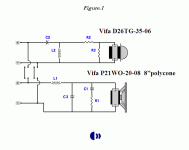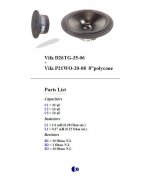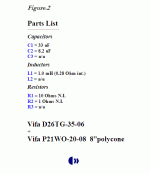Hey all. I am in need of some half way decent near-field studio monitors, but I just spent a bunch of money on other recording gear and my wallet is running dry. I have some drivers sitting around the house, and I was wondering if anyone knew of a way I could use any of them in a new speaker to save money. Even if I only use one of the components and have to buy another that would help. Here's what I've got:
Dayton DC28F-8 1-1/8" Silk Dome Tweeter
Dayton DC130AS-8 5-1/4" Classic Shielded Woofer
Vifa P21WO-20-08 8" Woofer
Vifa D26TG-35-06 1" soft dome tweeter
the two vifa drivers were originally purchased to build a pair of Linkwitz PMT1 dipole speakers. I guess I could follow through on that, any thoughts on if the PMT1 would work well as a near field monitor?
thanks for any help!!
If I don't end up building anything, I'd probably end up purchasing a pair of these Yamaha HS50M, so that gives you an idea of how much my absolute limit on cost is.
Dayton DC28F-8 1-1/8" Silk Dome Tweeter
Dayton DC130AS-8 5-1/4" Classic Shielded Woofer
Vifa P21WO-20-08 8" Woofer
Vifa D26TG-35-06 1" soft dome tweeter
the two vifa drivers were originally purchased to build a pair of Linkwitz PMT1 dipole speakers. I guess I could follow through on that, any thoughts on if the PMT1 would work well as a near field monitor?
thanks for any help!!
If I don't end up building anything, I'd probably end up purchasing a pair of these Yamaha HS50M, so that gives you an idea of how much my absolute limit on cost is.
Nevermind about the Yamaha HS50M's. I was hoping to get a good used price on them. I'd like to spend <$200 in parts. Ideally I could just use the drivers I have and spend say <$100 on crossover parts (or get a used pro-audio active crossover for that price, I have amps I can use).
I should note that I've never designed my own speakers, so i'm a bit weary on that. I do have an audio interface though, and some panasonic capsules I can make a measuring mic from. I just don't have any software to make a frequency response measurement.
I should note that I've never designed my own speakers, so i'm a bit weary on that. I do have an audio interface though, and some panasonic capsules I can make a measuring mic from. I just don't have any software to make a frequency response measurement.
>>> the two vifa drivers were originally purchased to build a pair of Linkwitz PMT1 dipole speakers. I guess I could follow through on that, any thoughts on if the PMT1 would work well as a near field monitor?
That looks like an interesting design. Thanks for posting. I would use the Vifa drivers to build a small monitor in a more typical bookshelf speaker but after seeing the PMT1 i would consider building those.
Godzilla
That looks like an interesting design. Thanks for posting. I would use the Vifa drivers to build a small monitor in a more typical bookshelf speaker but after seeing the PMT1 i would consider building those.
Godzilla
santiu said:
Vifa P21WO-20-08 8" Woofer
Vifa D26TG-35-06 1" soft dome tweeter
the two vifa drivers were originally purchased to build a pair of Linkwitz PMT1 dipole speakers. I guess I could follow through on that, any thoughts on if the PMT1 would work well as a near field monitor?
santiu said:
Nevermind about the Yamaha HS50M's. I was hoping to get a good used price on them. I'd like to spend <$200 in parts. Ideally I could just use the drivers I have and spend say <$100 on crossover parts...
Godzilla said:
That looks like an interesting design. Thanks for posting. I would use the Vifa drivers to build a small monitor in a more typical bookshelf speaker...
You can build a 2-way monitor with the Vifa's with a 2.order xover and sensitivity of 90dB (1m/1w) +/-1dB to 22KHz. Note: you must invert polarity for the tweeter to match a good phase with the woofer. You can cross them at 2K6 where the Vifa woofer starts beaming. You have to buy good quality audio parts like n. inductive power resistors.
It should be Ok with the design of a BR box and better reinforcement (alignment) of the low frequencies under 100Hz. I am looking at a reference of a 35ltr. box from the specs that is low about -4dB@100Hz from a reference of 0dB@200Hz.
Attachments
I emailed Linkwitz, and he doesn't think the PMT1 would serve well as a near field monitor as the speakers need some room for the front and rear waves to integrate. So, i guess I'll build a more standard bookshelf type speaker using the Vifa drivers.
Inductor, thanks for the design help. I'm new to crossover design, so let me see if I got this right. C2, L2, L1, and C3 make up the 2nd order crossover. R2 and R3 are a pad for the tweeter. And C1 and R1 serve as impedance correction. Is that right? How do I now go about calculating the values for all the components for the suggested 2kHz crossover.
Also, does anyone have any suggestions on the enclosure design? Should I use the 35l box used for the specs measurement? In which case what do I tune the box to? How about the baffle (does size matter? placement of the drivers? does it matter which way the port faces?)?
thanks for the input guys Sorry for all the basic questions.
Sorry for all the basic questions.
Inductor, thanks for the design help. I'm new to crossover design, so let me see if I got this right. C2, L2, L1, and C3 make up the 2nd order crossover. R2 and R3 are a pad for the tweeter. And C1 and R1 serve as impedance correction. Is that right? How do I now go about calculating the values for all the components for the suggested 2kHz crossover.
Also, does anyone have any suggestions on the enclosure design? Should I use the 35l box used for the specs measurement? In which case what do I tune the box to? How about the baffle (does size matter? placement of the drivers? does it matter which way the port faces?)?
thanks for the input guys
You’re correct about the functions of the components
For values, use a calculator: http://ccs.exl.info/calc_cr.html#second
(Be sure to use the ACTUAL impedance of the drivers at the xover freq)
For enclosure size, download WINISD Pro (free) : http://www.linearteam.dk/default.aspx?pageid=winisdpro
for baffle step, read Rod Elliots page: http://sound.westhost.com/bafflestep.htm
For values, use a calculator: http://ccs.exl.info/calc_cr.html#second
(Be sure to use the ACTUAL impedance of the drivers at the xover freq)
For enclosure size, download WINISD Pro (free) : http://www.linearteam.dk/default.aspx?pageid=winisdpro
for baffle step, read Rod Elliots page: http://sound.westhost.com/bafflestep.htm
This is inexpensive and has an option for a lower BSC version as well. Could be nice for near-field listening. Will also allow you to keep your existing parts to finish your dipole someday.
http://zaphaudio.com/audio-speaker19.html
Peter
http://zaphaudio.com/audio-speaker19.html
Peter
You already have the drivers for The "Dayton Budget 2-Way"
If you go to his site he has an improved crossover. You may want to experiment with less baffle step for your purpose.
Dayton 2 way
If you go to his site he has an improved crossover. You may want to experiment with less baffle step for your purpose.
Dayton 2 way
ocool_15 said:You already have the drivers for The "Dayton Budget 2-Way"
If you go to his site he has an improved crossover. You may want to experiment with less baffle step for your purpose.
Actually, that's what I'd be pirating those speakers from. I built a pair a while back, and while they sound okay, I'm not a big fan of them. I don't think I'd want to use them for mixing duty.
peter_m said:This is inexpensive and has an option for a lower BSC version as well. Could be nice for near-field listening. Will also allow you to keep your existing parts to finish your dipole someday.
http://zaphaudio.com/audio-speaker19.html
Peter
Ahh Zaph designs. That website is dangerous. I want to try out soo many of his designs. But every-time i start looking I end up wanting to build a pair of the Seas L15 design, or just go for broke withe ZD5. Maybe I should just suffer with headphone (at least I have a nice pair of HD580s) + crappy monitors right now while i save up for the parts to built one of those designs...
Parts List
2W X-Over VIFA-VIFA
2W X-Over VIFA-VIFA
Inductor, thanks for the design help. I'm new to crossover design, so let me see if I got this right. C2, L2, L1, and C3 make up the 2nd order crossover. R2 and R3 are a pad for the tweeter. And C1 and R1 serve as impedance correction. Is that right? How do I now go about calculating the values for all the components for the suggested 2kHz crossover.
Attachments
2K2_partslist 1-order
Here you have a very well calibrated design for Hi-Fi use w/ a good step/impulse response from a 1-order xover. Try this and choose the way you like. With this design you can adjust the power for the tweeter on the R2 alone (only one resistor for attenuation). With n/u for the components list, you just have to shunt this connection (i.e. not used). Give some feedback. The other thing is that this is a 1-order (phase is = or less than 90º, so it's very ok. Adjust distances between drivers for this effect. The other thing is that at full power the fs from the tweeter might show a little, but you can also test for moderate output at those frequencies 600-1000/1500 for full posterior operational use at overlap frequencies; xover freq. 2K2 - 89dB band pass, BSC=5dB (+/-) from 1K to 100Hz. Note: it lights up the high frequencies a little bit what some say is natural for an audiophile speaker.
Hope you like.
Here you have a very well calibrated design for Hi-Fi use w/ a good step/impulse response from a 1-order xover. Try this and choose the way you like. With this design you can adjust the power for the tweeter on the R2 alone (only one resistor for attenuation). With n/u for the components list, you just have to shunt this connection (i.e. not used). Give some feedback. The other thing is that this is a 1-order (phase is = or less than 90º, so it's very ok. Adjust distances between drivers for this effect. The other thing is that at full power the fs from the tweeter might show a little, but you can also test for moderate output at those frequencies 600-1000/1500 for full posterior operational use at overlap frequencies; xover freq. 2K2 - 89dB band pass, BSC=5dB (+/-) from 1K to 100Hz. Note: it lights up the high frequencies a little bit what some say is natural for an audiophile speaker.
Hope you like.

Attachments
Inductor, THANKS for the second crossover option! Between the two designs, which do you think will have a flatter frequency response? Since they'd be used as a studio monitor, flatness is important. In fact I sort of need the opposite of a "Hi-Fi" sound. If anything I'd rather have recessed high's and low's (emphasized mids).
You can have two external xovers and choose. Pay very much attention with connections. This is only good for you, not for friends or public studio because they might get mistaken very easily. Second order is better for your purpose, good phase and more linear across the spectrum. First order (second xover) is better for classic music, with good impulse response and less components, you can also test this one with a closed box (as for a 35L box or similar), with less bass but well-defined. Note that the first xover might have more neutral bass and highs and a more balanced overlap region because its merging is far better and in a shorter range of frequencies than in a first order, some people might not like that (short overlap region), it all depends. Again, if the first xover is not beaming at xover region 2K5 or 2K6, and it's merging is good then it's ok, if not it's xover frequency has to be lowered to the 2K2 region as the second one is. This does not mean you don't have to test them, because I never did and I don't know how they sound.
A good reference speaker from Richard Allan.
(more: http://www.ls35a.com/)
http://www.richardallanaudio.com/rallen/frames.htm
go to
Products
Studio Nearfield Monitors
RA8 m
(more: http://www.ls35a.com/)
http://www.richardallanaudio.com/rallen/frames.htm
go to
Products
Studio Nearfield Monitors
RA8 m
- Status
- This old topic is closed. If you want to reopen this topic, contact a moderator using the "Report Post" button.
- Home
- Loudspeakers
- Multi-Way
- Budget studio monitors from spare speakers?


